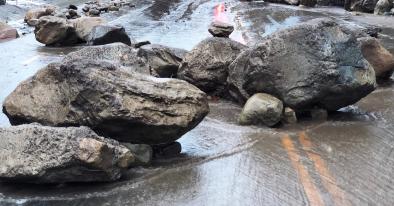How California’s record wildfire season paved the way for catastrophic mudslides

The slurries can start with almost no warning after as little as a third of an inch of rain in just 30 minutes — especially on slopes scorched by fires. After fires blazed across more than half a million acres this fall in California’s worst fire season on record, it’s not hard to find burnt land.
Fire makes slopes more susceptible to mudslides for a few reasons, according to climate scientist Daniel Swain’s Weather West blog. For one thing, flames can strip hillsides of plants that would otherwise anchor the dirt in place. Extreme fires that burn through thick vegetation can also physically change the soil — leaving behind a layer of water-repellant dirt near the surface. That layer acts like a raincoat, slicking off water that can then form mudslides, according to the USGS California Water Science Center.
Plus, without plants to slow the rain before it reaches the dirt, the soil can’t absorb as much water — leaving more to race down hillsides as runoff. Imagine the soil as coffee grounds in a filter: if you pour your boiling water slowly, it will soak into the grounds and drip through into your cup. But if you dump your boiling water all at once, a watery, muddy slurry will overflow. That’s what’s happening on the bare slopes of Southern California right now.
...
[W]hile the pattern of long dry spells and fires followed by floods and mudslides is familiar in the West, it could also be getting worse. “This situation that we’re seeing with the pronounced drought punctuated by wet conditions that are producing a lot of runoff — that is exactly what we are seeing intensify in the historical record,” Noah Diffenbaugh, a professor of Earth Sciences at Stanford University, told The Verge during California’s catastrophic deluge in February 2017. “And it’s exactly what climate models project for the future.”
Related Content






